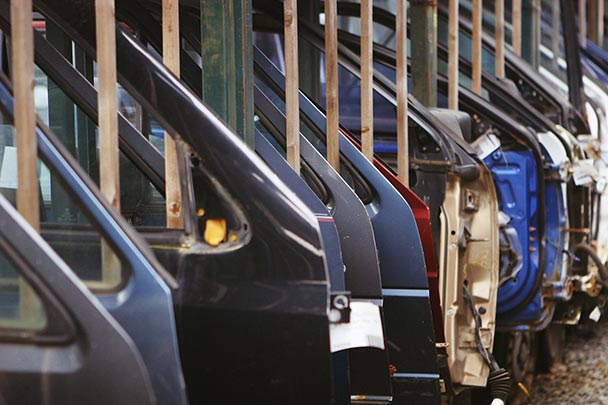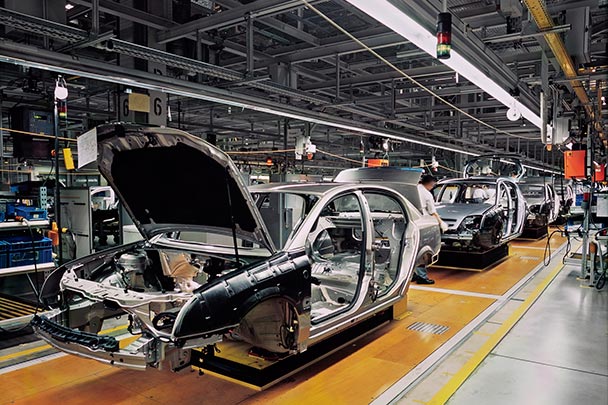Toyota
Basic Stability

So what is it that has given Toyota basic stability and success in production? In the simplest sense basic stability means consistent availability in terms of manpower, machines, materials, and methods: the 4Ms. No manufacturer wants to get too far down the road of its production without making sure that the 4Ms have been checked.
The reason is simple. Without basic items like machines or human resources in place you cannot run a production line efficiently. How do you know if you have enough stability in operations to proceed? The answer depends upon your ability to meet a few key needs:
- Do you have enough machine uptime to produce customer demand?
- Do you have enough material on hand to meet your production needs?
- Do you have enough trained employees available to handle the job?
- Do you have work methods, such as basic work instructions, in place?
If the answer is “no” to any of these questions, stop and fix the problem before going on. Attempting to flow product exactly to customer demand with untrained employees, poor supervision, or little inventory in place would be a mistake. Conversely, don’t fall into the trap of using these questions as excuses for not moving forward. Remember, you do not need perfect uptime in order to meet customer demand. For instance, if the line needs eight people to run and you consistently only have six people trained to do the job, then you have a basic stability problem.
How to Achieve Stability
To achieve basic stability, you should concentrate on four key elements corresponding to the 4Ms.
1. Manpower

Basic stability starts with a well trained workforce. Fortunately employees tend to know their jobs very well or we would all be in serious trouble.
Managers need to learn basic techniques about supervision in production and how to further improve the skills and capabilities of work teams. These three specific job training components for production supervisors are job instruction, job methods, and job relations.
Job instruction (JI) teaches supervisors how to plan for the correct resources they need in production, how to break down jobs for instruction, and how to teach people safely, correctly, and conscientiously.
Job methods (JM) teach supervisors how to analyze jobs and make simple improvements within their control. Supervisors learned to question why an activity was done the way it was, and if it could be eliminated, combined with something else, rearranged, or simplified.
Job relations (JR) teaches supervisors how to treat people as individuals and solve human-related problems in production rather than to ignore them.
Taken together these three areas help supervisors create a basic routine, discipline, and sense of fairness in work teams.
2. Machines

You do not need equipment with perfect uptime, but you must know your customer demand, the capacity of your process, and the actual average output. If you have theoretical capacity as well as demonstrated capacity to meet customer demand then there is no problem. It is only when you have no demonstrated capacity to meet demand that you have a basic machine stability problem. For example, if customer demand is 700 units per shift and your actual output is only 500 units despite having the capacity for 1000, then you need more availability.
3. Materials

In general the goal is to reduce waste and shorten the timeline from when an order is received until the time it is produced. Normally this requires a reduction of inventory. If you suffer from basic instability, however, you might need to increase inventory in the short term in some places. Here are two pieces of advice:
- First, not all inventories are waste. Only inventory beyond what is needed to run the process is waste.
- Second, inventory often exists as a symptom of a problem in the process. Solving the problem earns you the right to reduce the inventory.
4. Methods

Finally, achieving basic stability requires having standard methods of manufacturing. The key point here is the definition of a standard. The normal definition is that a standard is a rule or way to do things. However, people are not encouraged to question or change the rule. “We do it this way because that is our company standard” is a phrase workers often hear. Perhaps, the definition of a standard could be stated slightly differently: “A standard is a rule or a basis for comparison.” Thus, a standard is a tool to measure how we are doing something and refer to when we want to make a change. Efficiency is about changing work methods in order to eliminate waste and make improvements. The standards are what we use to measure and compare our changes so that we know if the new way is better or not. In some companies, this improvement thinking is set in the minds of all employees. Therefore, everyone is encouraged to make changes. However change is only implemented and maintained if it beats the old standard.
Summary
There are many other elements of basic stability. For instance, we could add a fifth M for Metrics. However, the final point is this: New companies struggle with establishing efficient production. Along the way, they discovered that they need basic stability before they can improve. Much like we need to crawl and walk before we can run, companies often find that they need to improve their basic stability before they can expect overall improvement.